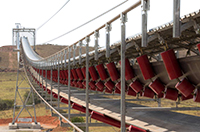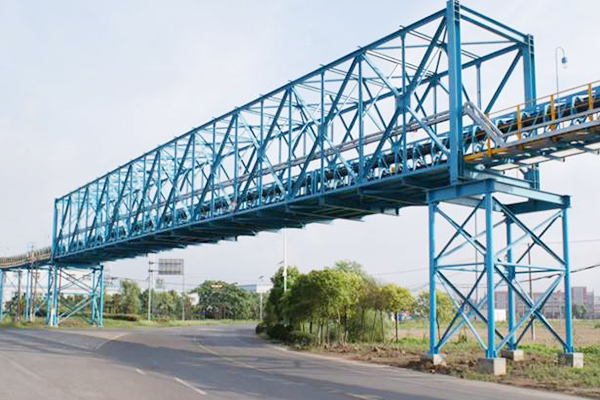Preparatory work before installation of the belt conveyor: measure the spacing of the embedded bolts before installation, measure the elevation of each installation foundation with a level, and mark the centerline of the headstock and tailstock, and then use theodolite to find the belt installation baseline;
Installation process: basic acceptance-belt conveyor leg and middle frame installation-counterweight device installation-headstock, tailstock and drive device frame installation-drum and roller installation-unit installation-belt pulling- -Refueling and debugging belt conveyor for bulk materials.
Belt conveyor installation process
1. Belt conveyor legs and intermediate frame: Use theodolite to find the center line before installation, and then draw the position of the pile points of each leg according to the center line position. If there is embedded iron, make appropriate adjustments according to the position of the embedded iron Adjust to facilitate the installation company, each support leg should be welded firmly with the embedded part;
2. Counterweight device: When installing the counterweight device, the parallelism between the two force columns should be ensured, and at the same time its verticality should be ensured. After the counterweight device is installed, the protective railing should be installed immediately in consideration of safety;
3. Headstock, tailstock and driving device frame: first check the elevation of the installation foundation, find the center line, and pay attention to the axis deviation of the head and tailstock not to exceed ±1.5; pay attention to the setting of the shim during installation. According to the specification, the shim should be placed at the main load-bearing position. A pair of shim should be placed on both sides of each connecting bolt. The oblique shim should be set in pairs. The number of shim should not exceed 5. The shim should be thinner. The shim is placed in the thicker middle. After adjustment, the shim should be welded firmly and the bolts should be tightened;
4. Roller and idler: When installing the drum and idler, check the rotation of the bearing part. If there is any inflexible rotation, it should be repaired or replaced in time. The driving roller and the reversing roller need to be adjusted during debugging, and the tightening torque of the bolts is 75-80% of the final tightening torque;
5. Unit installation: Unit installation should meet the requirements of "General Specification for Construction and Acceptance of Mechanical Equipment Installation Engineering" (GB50231-98) and relevant national codes. The deviation of the center line of the unit is 0.02mm, the radial error of the coupling is 0.05mm, the end-face runout value is 0.02mm, and the gap between the half couplings is 3~5mm; the levelness of the unit and the pad iron should also be ensured. The use meets the specification requirements;
6. Pull the belt: the manufacturer or professional is responsible;
7. Refueling and debugging: make a refueling record when refueling, add appropriate mechanical oil or gear oil according to the reducer model, and the amount of refueling is as long as the indicated position; add butter (lithium-based grease) to each bearing seat position of the belt conveyor; debugging; Personnel should be placed at the head, tail and middle of the belt conveyor. The staff should pay attention to whether the belt conveyor is running normally. If there is a fault or serious deviation, the operation should be stopped immediately; the inching should be taken first during the trial operation. When the electric is normal Debugging again; after the belt conveyor runs off track, the staff should adjust the relevant parts based on experience, and ensure the normal operation of the belt conveyor after multiple adjustments. The staff should also use the walkie-talkie or blow the whistle to keep in touch, always pay attention to the safety of the machine and personnel (self and others), and strictly prohibit illegal operations; check the temperature of the motor, reducer and each bearing position during commissioning, and check the reducer with a stethoscope Noise and make debugging records....








